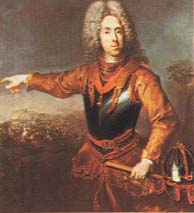IV)
Landrecies is finally French ! (1655 - 1794)



In 1651, the new French king Louis XIV came of
age, and he was willing to rule the country on his own, that is to say without
the constant intervention of cardinal Mazarin, the powerful successor of
Richelieu. The Spanish war hadn't come to an end yet, and a military victory
would have been the best solution to give the young monarch more legitimacy.
That's why the battle of Landrecies in 1655 came at the right moment.
At that time French royal troops, led by two
marshals named Turenne and La Ferté, arrived in front of the Landrecian walls.
The siege would be very difficult to sustain, and the two marshals knew it :
indeed, since the building of the fortifications of 1543 by Francois Ist, the
quality of the ramparts had been steadily improved by the Spanish garrison.
However the victory was something necessary for France, because the country
couldn't afford to exhaust itself in this endless war anymore.
After a few days, the stronghold eventually
capitulated. Turenne and La Ferté entered the town as conquerors : they
didn't know yet that this would make the town French till today. The seizure of
the town had a deep psychological impact in Landrecies but also throughout the
whole country. An engraver of the 17th century, named Nicolas Pérelle,
created a work where one can see the fight of some Spanish and French troops,
with Landrecies and its ramparts in the background :

In 1659, the Pyrenees Treaty temporarily ended
the Spanish war. The French sovereignty over Landrecies was officially
acknowledged and accepted by Madrid. A few years later, Louis XIV would wage new
wars against Spain and win some new territories in the north : the "Devolution
war" (1665-1668)
brought Lille and Douai to France. In the Holland war (1672-1679)
French troops took control of Valenciennes, Maubeuge and Cambrai. In 1679, the Nimègue
Treaty defined the French northern border as it still exists today...
As soon as Landrecies became French, its
fortifications were upgraded : indeed the famous Vauban built new and very
efficient ramparts. Thanks to them, most of the last sieges that the town had
still to endure would fail.

Under the French rule, Landrecies fastly grew
into an important local military center. As soon as 1661, the town became a
royal "prévôté", that is to say a judiciary, administrative and military center.
Then for some decades Landrecians were able to
enjoy a peaceful existence, but things got more complicated in 1700. At that
time, the Spanish king
Charles II died. In his will, he had chosen to bequeath his kingdom to the duke
of Anjou, who was Louis XIV's grandson. For the neighbors of France, there was
an obvious danger : if the duke of Anjou did inherit Spain, and if he inherited
France too at the death of Louis XIV, then a new superpower gathering France and
Spain would emerge. That's why the other European countries (Holy Empire,
England, Holland, Denmark,
Savoie...) formed a coalition to thwart the Franco-Spanish ambitions. This
was the beginning of the Spanish Succession War, also known as Queen Anne's War.
The coalition featured a good deal of
prestigious military leaders, and among them was Eugene of Savoie, nicknamed "Prince
Eugene". This skillful warrior was in charge of the imperial troops, and was a
match for French generals like the duke of Villars.

In 1712, France was in a critical situation, as
foreign armies were invading it from every part. Prince Eugene and his army were
marching through the northern part of the country, looking for their enemy the
duke of Villars. Eugene was quite self-confident, and he decided to besiege
Landrecies. But Landrecians were used to this kind of situation, and so they
opposed a heroic resistance to Eugene's assaults. Eugene didn't give up, and
chose to stay under the walls of Landrecies with a large part of his army, while
sending the rest of it to find Villars. Thus, when the two armies faced each
other at Denain, imperial troops were seriously weakened by this lack of
soldiers, and that's why Villars had no difficult in crushing them. The victory
of Denain virtually preserved France from a total invasion. In other words, the
war had a happy ending for France mostly because of Landrecians' bravery. This
was the first great service that the little town gave to the French nation.
Prince Eugene, who was totally humiliated, had
to give up the siege and to leave, while some Landrecians were scoffing at him
from the top of the walls. A peace treaty was signed at Rastatt in
1714.
The 18th century was the peak of the Landrecian
military tradition. For example, several big military barracks were built inside
the town in that period : the duke of Biron, who was the governor of Landrecies
from 1735 to 1757, had one of them erected in upper town. The building, which
came to get his name, still exists today. Another one
was built in lower town, and was named St-Charles barracks. It was designed for
cavalry brigades. After the revolution, it was renamed
Clarke barracks, in tribute to this famous
Napoleonic marshal born in Landrecies. This one too has survived till today,
on the east side of the main street. On the contrary, a third one, which was
named St-Philippe and then Dupleix barracks, was razed to the ground in the 20th
century, in order to build a sociocultural center.

All these new buildings soon turned out to be
very useful. The French revolution began in 1789, with the storming of the
Bastille on July 14th. In April 1792, the war against Austria began. Austrian
troops arrived in front of Landrecies two years later, in April 1794. Since the
sieges of the 16th and 17th centuries, there had been a lot of technical
advances as far as warfare is concerned, and Landrecies wasn't up to it.
From April 17th to April 24th, Landrecians had
to suffer devastating artillery fires. According to some accounts of the time,
there were only about 10 houses remaining intact after the bombing.
Most contemporary historians agree on the extraordinary resistance of the
inhabitants,
and especially of a remarkably brave woman called Marguerite Grumiau. Today a
Landrecian street bears her name. Eventually the town fell to its enemies, as
well as the rest of the Hainaut and the Avesnois regions. However the Austrian
rule was short-lived, because General Sherer and his revolutionary troops
liberated the town as soon as July.

The French government was really impressed by
the resistance of Landrecies,
and it decided to pay on its own all the expenses needed for the reconstruction
of the town, because "Landrecians have served their country well" (that's
what the decree of "27 Ventôse an III" said, and since then it has become
the motto of the town's blazon). Moreover, the town was promised
a little monument to celebrate the memory of this
date : actually it would be only erected in 1899 ! And later, for this glorious
period of its history, the whole town was awarded the Legion of Honour, which is
the highest honorary distinction in France. Even today, only 13 other towns out
of the 36,000 French communes have it !
Next
: Under the burden of a heavy
past (1794 - today)










